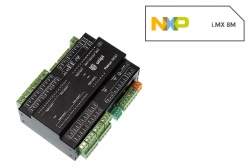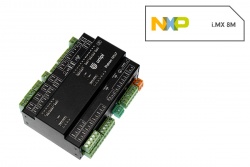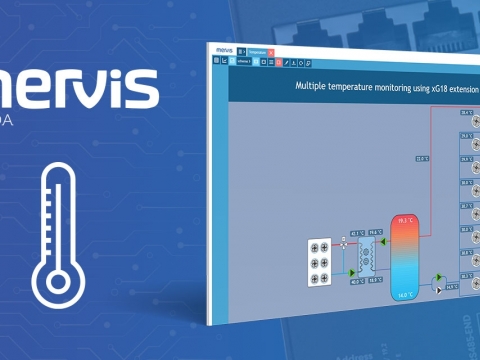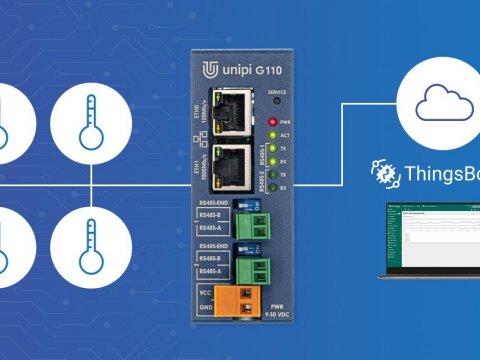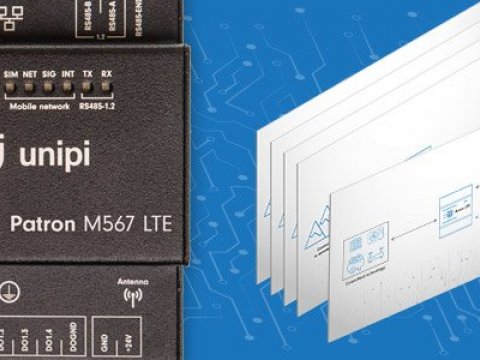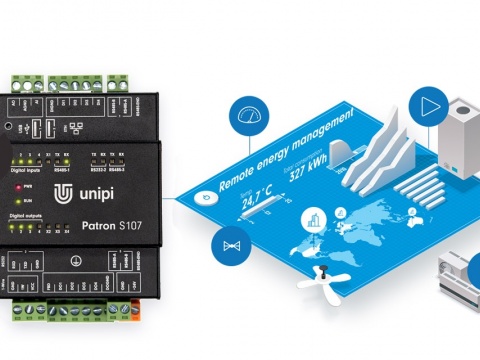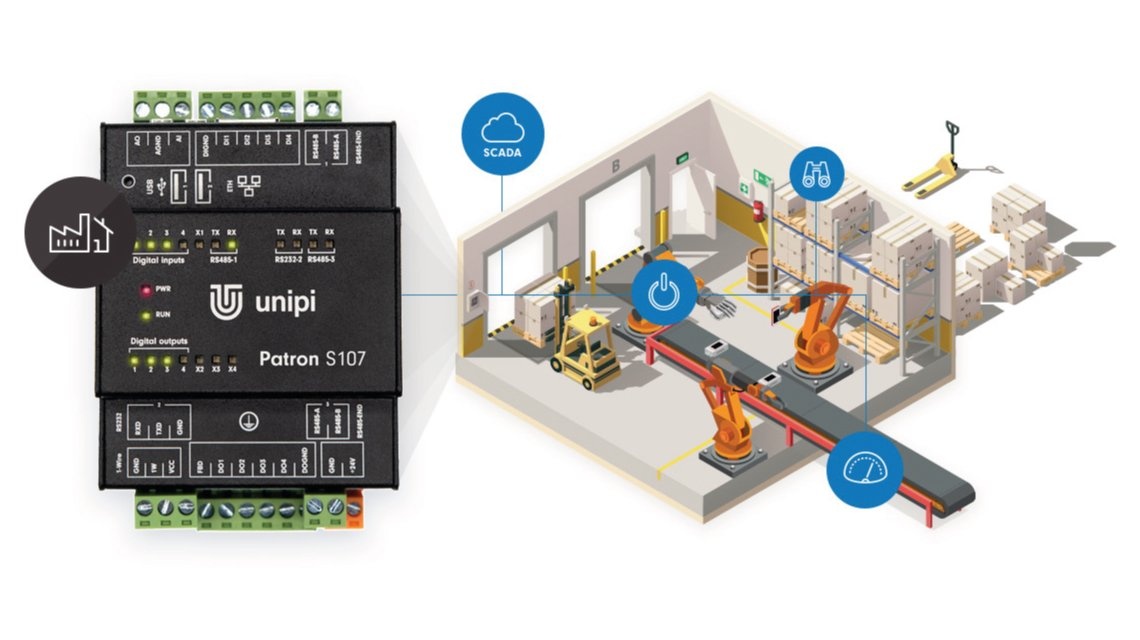
Industry automation will offer you a wide range of options to optimize your production and increase its effectiveness. From advanced monitoring to manufacturing automation, you can optimize and decrease energy consumption, reduce the error rate or decrease the employee requirements - all of which can significantly decrease your expenses for energy and maintenance. Unipi technology open-source programmable logic controllers can then serve as a heart of your system and usher your business into the age of Industry 4.0.
Manufacturing automation
Injection moulding machines, solar power plants, paper mills, conveyor belts and many more - by automating such facilities, you can significantly increase the potential of your business. Automation of routine repeating tasks will increase the production rate, decrease the error rate and reduce the number of required operators. A programmable logic controller (PLC) with the corresponding programming, connected to a set of control devices (valves, compressors, pumps, external relays etc.), can autonomously regulate the device's operation, resulting in production optimization and cost reduction. Automatic regulation can also prevent not only human errors but also production stoppages by adjusting operation parameters in case of abnormalities or emergencies (overheating, overpressure, mechanical issues etc.) and notifying the operator - all of this without the need for human input.
Industrial gateways & user interface
By using the controller as an IoT gateway, even older machines can be connected to factory automation networks. Through the gateway, you can monitor operational data and production rates through SCADA interface, or store these data on the online database for further analysis - all of this without the need for machine replacement. You can also get the option to control the device both locally through touchscreen control panels, or remotely through wireless technologies and a web interface. That makes the industrial gateway a highly profitable asset, allowing you to control and regulate your business without the need for large investments into modernization or new machinery.
Heating, ventilation, air conditioning (HVAC)
The combination of environmental sensors and HVAC regulation systems will allow you to effectively regulate temperature and humidity in your facility. An intelligent automation system can autonomously regulate the operation of air conditioning or heating sources to adjust the indoor temperature according to preprogrammed values. This feature will allow you to provide your employees with a comfortable and healthy environment with optimal temperature, humidity and carbon dioxide levels, thus increasing their productivity. In some fields of the industry, smart ventilation can also contribute to improving manufacturing efficiency. For example, a CNC factory can automate vacuum manifold used to hold workpieces on the tables. An intelligent system can dynamically adjust vacuum pumps according to current vacuum demand to balance vacuum output and energy consumption.
Temperature measurement
By using a network of smart temperature sensors, you can get precise real-time temperature measurements. Depending on the sensor type chosen, you can measure indoor/outdoor temperature by wall-mounted sensors, you can measure temperature both inside and outside of pipelines, or you can mount sensors for measuring large vessel inside temperature. Sensors can be provided with universal inputs/outputs; alternatively, you can use sensors using the widely utilized 1-Wire bus. Real-time sensor data are then received by the controller, which can either display them through SCADA interface or store them in a cloud database for further analysis and evaluation. By connecting the network to the internet, you can then remotely collect, monitor and evaluate data from multiple facilities at once, regardless of distance.
Smart lighting control
Modern smart lights can provide your facility with optimal light levels regardless of the current time or season. Provide your employees with enough light through intelligent light sources, which can be not only switched on/off but also dynamically regulated. A controller with the corresponding programming will then give you the option to either control lights centrally, or a fully autonomous mode adjusting the light intensity according to the current time and amount of natural light. Lights can be also controlled individually or in pre-set groups or zones based on the light requirement of the particular area. Last but not least, smart lighting will bring you a large decrease in energy costs - lights can be automatically switched off when the employee leaves his workstation or regulated to achieve a balance between light intensity and energy saving.
Quantity regulation & monitoring
A network of smart meters will allow you to monitor the consumption of water, gas, electricity and other quantities and store the collected real-time data. By comparing the data over time, you can then optimize the production, increase production rate and increase the productivity of your employees. A suitably programmed system is also able to detect abnormalities in the operation of the machinery and notify the operator by autonomously monitoring and analyzing energy consumption, noise levels, and other variables. This will, in turn, allow you to take corresponding precautions in advance (worn-out component replacement, preventive maintenance or repairs) to prevent any critical failures or production stoppages.
SCADA
SCADA acronym stands for Supervisory Control And Data Acquisition. In the context of industry 4.0, SCADA will give you the option to control and monitor all devices connected to your enterprise network through a single graphical interface. Using a network of data points, SCADA allows offers the user the ability to control and monitor both the whole system and each data point. With SCADA, you can easily supervise your entire plant and collect operation data in the form of comprehensible graphs or tables. With SCADA, you can get an overview of the operation of multiple plants or factories, regardless of their distance.
Industrial automation control
A suitable programmable logic controller (PLC) allows you or your employees to monitor the operation of your plant both locally through touchscreen control terminals placed directly next to the machinery, and remotely by using the SCADA interface. Those same features can be used also for the effective control and regulation of individual system components or whole control device units.
Unipi technology controllers - a brain of your business
Unipi open-source gateways and controllers can be utilized in both creating new systems or modernizing already existing machinery. Unipi products feature a high level of reliability, compact size and wide compatibility due to software openness. Controllers are designed for standard DIN rail mounting and can be easily installed into distribution boxes or control units without the need to stop or limit the plant's operation. For industrial automation control, we recommend the Unipi Patron, our latest IoT controller/gateway production line. The Patron features a larger operating temperature range, a high memory capacity for storing complex operation programming and a wide range of communication interfaces. All these features make the Patron a perfect choice for industry 4.0 applications.
If your business requires specialised solutions, you can opt for Patron variants featuring special features
Patron LTE
Unipi Patron M267 LTE and M567 LTE controllers include an interface for wireless LTE communication, making them useful in two main applications - primary and backup network connection. In the primary connection scenario, the Patron LTE controller can be used for remote management of technologies placed in remote or inaccessible locations or projects that do not feature their own wired connectivity. The second use case then utilizes LTE controllers in technologies reliant on the stable communication link between the technology and a supervision centre; if the primary network connection fails, the Patron LTE automatically switches to LTE network, prevents communication loss and averts any issues stemming from communication downtimes.
Learn more about Patron LTE in the corresponding case study.
Open software
Unipi PLCs are based on the Linux OS and support a wide variety of both professional and open-source solutions. The main supported platform is the Mervis control system, featuring a SCADA interface for remote management and monitoring, a cloud database for data storage and analysis, and comprehensible development environment. Unipi Neuron and Unipi Patron controllers are supplied with a Mervis license for access to database and Mervis proxy server. The Patron line then has the Mervis already installed (the system can be re-flashed manually).
Unipi controllers can be also easily integrated into already existing solutions by using our SDK development kit (see below).
Industry automation - first steps
Due to their compact size and easy installation, Unipi controllers can be integrated into any industrial or manufacturing automation network. You do not need to worry about large investments into machinery replacement or new software solutions; Unipi controllers can function as an industrial IoT gateway, providing a communication bridge between existing machinery and new features (SCADA, temperature or other sensors, control and regulation units etc.) for a fraction of extensive modernization costs. The subsequent reduction of maintenance or energy costs due to automation then makes Unipi controllers an investment with a very short payback period.
Your programmers can use our SDK development kit for the integration of Unipi into your network. This kit contains three applications (EVOK open-source API, Modbus-TCP protocol and SysFS hardware access interface), which is compatible with the most of currently used software solutions and program languages and allows you easy access to Unipi hardware without the need for extensive programming or communication protocol specification, significantly speeding up both the integration and the application development.
Due to the flexibility of technologies used, Unipi technology can offer its customers a wide range of customization options. From 20 MOQ (minimum order quantity), the customer can order both Unipi PLC and its package in a custom colour and with the customer's company logo. Such an option is an ideal choice for customers planning to implement the Unipi hardware into their own automation solutions.
Last but not least, you can also use the Unipi as a basis for custom functionality development. The modular architecture makes it possible to develop new combinations of I/Os or to implement new technologies according to your specifications. From 200 MOQ, the Unipi technology development team will prepare the best solution for your needs
